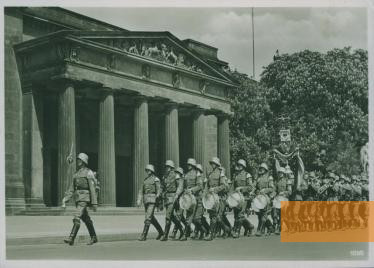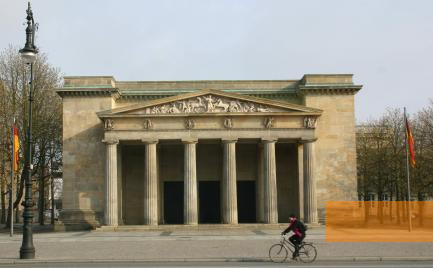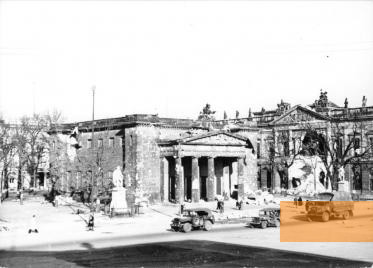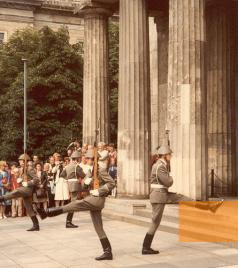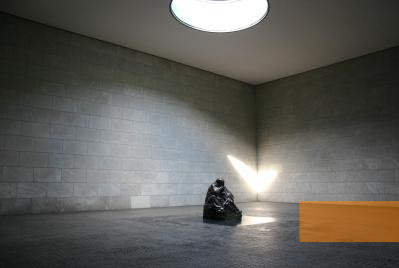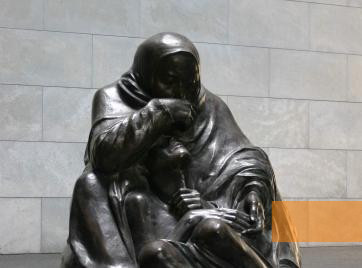Since 1993, the Neue Wache has been the »Central Memorial of the Federal Republic of Germany for the Victims of War and Tyranny«.
The Neue Wache (English: New Guardhouse) was built between 1816 and 1818 in close vicinity of the Berlin City Palace as a guardhouse for the troops of the Crown Prince of Prussia and as a memorial to the soldiers who died during the Napoleonic Wars. Designed by Karl-Friedrich Schinkel, it is considered one of the prime examples of German Classicism.
Over the years, the Neue Wache has frequently been remodelled and rededicated. Guard parades took place here in the 19th century. After the First World War and the collapse of the German Empire, the Neue Wache lost its original military function. After long lasting debates, the Neue Wache was remodelled according to a design by architect Heinrich Tessenow as a memorial site to soldiers who died during the First World War. A windowless room with only a circular skylight was set up in the interior. The light from the oculus shone onto a granite block on which lay a stylised oak wreath. The National Socialists used the memorial to glorify soldiers' deaths. The »Berlin Guard Regiment« staged a changing of the guard several times a week. Shortly before the end of World War II, the Neue Wache was severely damaged during air raids.
In the GDR, the Neue Wache was rebuilt and dedicated as the »Memorial to the Victims of Fascism and Militarism« in 1960. In 1969, the memorial's interior was redesigned by Lothar Kwasnitza. Two urns containing the ashes of an unknown soldier and an unknown resistance fighter were embedded on earth from the battle fields of World War II and from National Socialist concentration camps. An eternal flame was added, as well as the coat of arms of the GDR. Between 1962 and 1990, soldiers of the »Friedrich Engels« guard regiment stood in front of the building; every Wednesday and Saturday the »great change of guard« took place.
Over the years, the Neue Wache has frequently been remodelled and rededicated. Guard parades took place here in the 19th century. After the First World War and the collapse of the German Empire, the Neue Wache lost its original military function. After long lasting debates, the Neue Wache was remodelled according to a design by architect Heinrich Tessenow as a memorial site to soldiers who died during the First World War. A windowless room with only a circular skylight was set up in the interior. The light from the oculus shone onto a granite block on which lay a stylised oak wreath. The National Socialists used the memorial to glorify soldiers' deaths. The »Berlin Guard Regiment« staged a changing of the guard several times a week. Shortly before the end of World War II, the Neue Wache was severely damaged during air raids.
In the GDR, the Neue Wache was rebuilt and dedicated as the »Memorial to the Victims of Fascism and Militarism« in 1960. In 1969, the memorial's interior was redesigned by Lothar Kwasnitza. Two urns containing the ashes of an unknown soldier and an unknown resistance fighter were embedded on earth from the battle fields of World War II and from National Socialist concentration camps. An eternal flame was added, as well as the coat of arms of the GDR. Between 1962 and 1990, soldiers of the »Friedrich Engels« guard regiment stood in front of the building; every Wednesday and Saturday the »great change of guard« took place.
The Neue Wache memorial honours the soldiers who died during the two world wars and those who suffered during these wars: the Jews persecuted under National Socialism, Sinti and Roma, resistance fighters, homosexuals and victims of »euthanasia«. The dedication also includes those who were persecuted by the GDR regime and murdered after 1945.
After German reunification, the German government decided to once again redesign the interior of the Neue Wache according to Heinrich Tessenow's concept. In 1993, the Neue Wache was rededicated on the initiative of chancellor Helmut Kohl as the »Central Memorial of the Federal Republic of Germany for the Victims of War and Tyranny«. The interior now contains an enlarged bronze copy of a sculpture by Käthe Kollwitz - »Mother with her dead son«. There are two memorial plaques at the entrance to the Neue Wache. One of them contains information about the varied history of the building, the second refers to the memorial's designation as a »memorial site to the victims of war and tyranny«. Critics of the memorial have questioned the appropriateness of the »Mother with her dead son« sculpture at a memorial dedicated to all victim groups. Others have remarked critically that the dedication to »victims of war and tyranny« could blur the line between victims and perpetrators. To help overcome these doubts an additional memorial plaque specifying the various victim groups commemorated was affixed at the entrance.
- Name
- Neue Wache
- Address
-
Unter den Linden 4
10099 Berlin - Open
- The interior of the Neue Wache is open daily from 10 a.m. to 6 p.m.


